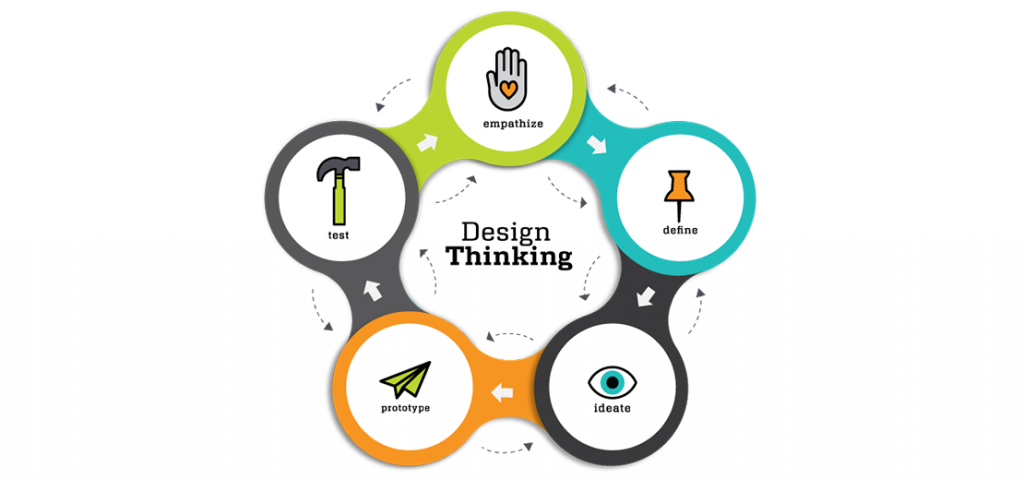“Design thinking is a human-centered approach to innovation that draws from the designer’s toolkit to integrate the needs of people, the possibilities of technology, and the requirements for business success.”
— Tim Brown, CEO of IDEO
Design thinking is a concept used for practical and creative problem solving, especially in business environments. This principle is largely based on the methods and processes that designers use, but has actually evolved from various areas – including engineering, architecture and business. Design thinking can be applied to any area; it does not necessarily have to be specific to design, though designers are deserving of the name.
Design thinking focuses on the human resources that the company owns and which is highly targeted to the user. It strives to understand the needs of people and to design effective solutions that will meet these needs.
Have you become curious now?
“Design thinking taps into capacities we all have but that are overlooked by more conventional problem-solving practices. It is not only human-centered; it is deeply human in and of itself. Design thinking relies on our ability to be intuitive, to recognize patterns, to construct ideas that have emotional meaning as well as functionality, to express ourselves in media other than words or symbols. Nobody wants to run a business based on feeling, intuition, and inspiration, but an overreliance on the rational and the analytical can be just as dangerous. The integrated approach at the core of the design process suggests a ‘third way.’ “
– Tim Brown, Change by Design, Introduction
What are the 5 Stages of Design Thinking?
The 5-stage model was originally proposed by the Hasso-Plattner Institute of Design at Stanford, and individuals and companies are constantly using it to better innovate.
Empathise – with your users
Define – your users’ needs, their problem, and your insights
Ideate – by challenging assumptions and creating ideas for innovative solutions
Prototype – to start creating solutions
Test – solutions

Out-of-frame thinking can provide an innovative solution to the problematic situation and everyone can share their ideas with the solution. However, out-of-box thinking can be a real challenge as we naturally develop patterns of thinking based on recurring activities and the often available knowledge that surrounds us.
A few years ago, an incident occurred in which the truck driver tried to pass under a low bridge. But he did not succeed and the truck was firmly under the bridge. The driver could not continue the ride or turned backward.
It is said that the truck is stuck, has caused massive traffic problems, resulting in gathering emergency personnel, engineers, firefighters and truck drivers to design and arrange different solutions for ejecting the captured vehicle.
Emergency workers discussed whether to dismantle parts of the truck or to detach parts of the bridge. Everyone was talking about a solution that fits in to his or her level of expertise.
The boy who walked beside him and testified of intense debate, looked at the truck on the bridge, then looked at the road and said helplessly, “Why do not you just drop the air out of the tires?” to the absolute surprise of all the experts and experts trying to solve the problem.
When the solution was tested, the truck could easily drive after having only suffered the damage caused by the first attempt to pass under the bridge. The story symbolizes the struggles we are facing where the most obvious solutions are the one that is most difficult to reach because of the self-imposed limitations in which we work.
“The ‘Design Thinking’ label is not a myth. It is a description of the application of well-tried design process to new challenges and opportunities, used by people from both design and non-design backgrounds. I welcome the recognition of the term and hope that its use continues to expand and be more universally understood, so that eventually every leader knows how to use design and design thinking for innovation and better results.”
– Bill Moggridge, co-founder of IDEO, in Design Thinking: Dear Don
Design thinking is often referred to as “out of the box of thinking,” as designers are trying to develop new ways of thinking that do not adhere to dominant or common problem-solving methods – just as artists. The focus of design thinking is to improve products by analyzing the way people communicate with them and exploring the conditions in which they work. Design thinking offers us a deeper digestion tool to find ways to improve user experiences. Each company has the opportunity to improve its business, and the best way is that every employee feels free to improve the quality of their business with their ideas.
Is not it so? 😉
References:
What is Design Thinking and Why Is It So Popular? URL:
https://www.interaction-design.org/literature/article/what-is-design-thinking-and-why-is-it-so-popular
Bill Moggridge, “Design Thinking: Dear Don”, 2010:
http://www.core77.com/posts/17042/design-thinking-dear-don-17042
Tim Brown, Change by Design: How Design Thinking Transforms Organizations and Inspires Innovation Introduction, 2009


